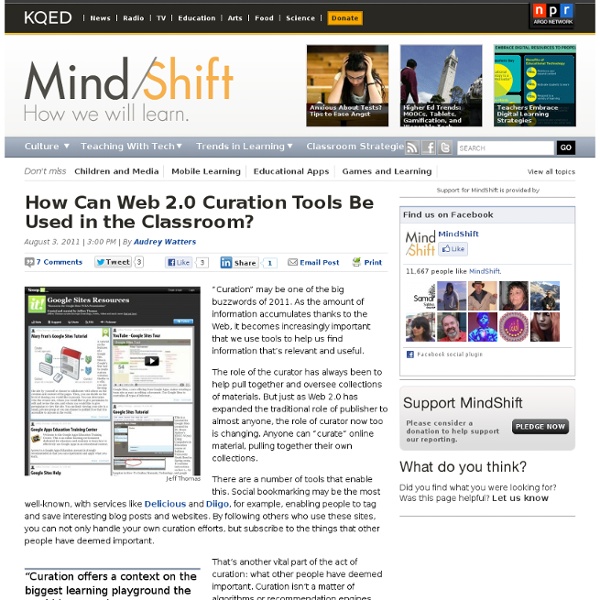How Can Web 2.0 Curation Tools Be Used in the Classroom?
Digital Tools Jeff Thomas “Curation” may be one of the big buzzwords of 2011. As the amount of information accumulates thanks to the Web, it becomes increasingly important that we use tools to help us find information that’s relevant and useful. The role of the curator has always been to help pull together and oversee collections of materials. There are a number of tools that enable this. “Curation offers a context on the biggest learning playground the world has ever known.” That’s another vital part of the act of curation: what other people have deemed important. While the Web has perhaps democratized who can be an expert, we do still prefer to turn to those with specific backgrounds and from specific professions, especially when it comes to education.One interesting new curation tool is Scoop.it. Curation was once the purview of experts and professionals who collected and preserved resources. Related Explore: Scoop.it
La puce et le neurone : deux mots sur la “curation”
Ah le vilain mot que celui de « curation » ! Il y a décidément des anglicismes qui passent mal. Je ne sais pas pourquoi on ne lui préfère pas le terme d’édition, fût-il imparfait. Quoi qu’il en soit, c’est depuis quelques mois un des mots à la mode sur le Web et il recouvre quelque chose d’important : essayons donc de remonter du son (bruyant) au sens. Mais tout d’abord, qu’est-ce que la curation ? Maintenant, si l’on considère le Web, on comprend aisément pourquoi c’est une notion importante. Pour ne parler que du Web moderne, celui qui dans mon esprit commence au milieu des années 1990, deux méthodes de curation se dégagent : l’humaine et l’algorithmique. La curation humaine, c’est « David and Jerry’s Guide to the World Wide Web« , à savoir Yahoo! Delicious, né durant les années 2000, est une autre start-up qui fit date et, à mon avis, la start-up la plus emblématique du Web 2.0. Il est assez aisé de tracer les principaux avantages et inconvénients de ces deux approches.
schooX - The Academy for Self Learners - Online Courses and Certificates
What Can Social Media Aggregation Contribute To Teaching & Learning
Justice: What's the Right Thing to Do?
PART ONE: WHATS A FAIR START? Is it just to tax the rich to help the poor? John Rawls says we should answer this question by asking what principles you would choose to govern the distribution of income and wealth if you did not know who you were, whether you grew up in privilege or in poverty. Wouldnt you want an equal distribution of wealth, or one that maximally benefits whomever happens to be the least advantaged? After all, that might be you. Professor Sandel recaps how income, wealth, and opportunities in life should be distributed, according to the three different theories raised so far in class. PART ONE: WHATS A FAIR START?
Who are your curators? | Content curator | Digital Curator
I had already planned to write a post about “curators” today when I noticed that Jeff De Cagna has posted about the “content challenge” over on SmartBlog. He sees “content curation” as one of the most significant innovation opportunities available to organizations. We’re in agreement on that and have spoken together about it before. Here on Mission to Learn, though, I’d like to focus on it as one of the most significant innovation opportunities for individual lifelong learners. First things first: What is a Curator? The idea behind curators and content curation is that there is such a flood of new content pouring through the Internet pipes these days that being aware of all of it and sorting it out in meaningful ways is simply not possible. Bottom line: A curator is an individual or organization who excels at helping others make sense. For the individual lifelong learner, I see (at least) two powerful opportunities here. The first is to find great curators. The second is to be a curator.
Why Curation Will Transform Education and Learning: 10 Key Reasons
There is a growing number of key trends that are both rapidly revolutionizing the world of education as we know it and opening up opportunities to review and upgrade the role and scope of many of its existing institutions, (as the likeliness that they are going to soon become obsolete and unsustainable, is right in front of anyone's eyes). George Siemens, in his recent Open Letter to Canadian Universities, sums them up well: 1) An Overwhelming Abundance of Information Which Begs To Be OrganizedThe goal is not (and probably it never was) to learn or memorize all of the information available out there. It's just too much even if we focus only on the very essence of it. The goal is to learn how to learn, to know where to look for something and to be able to identify which parts of all the information available are most relevant to learn or achieve a certain goal or objective.This is why new digital literacy skills are of such great importance. From the New York Times: "...Mr.
Related:
Related:



